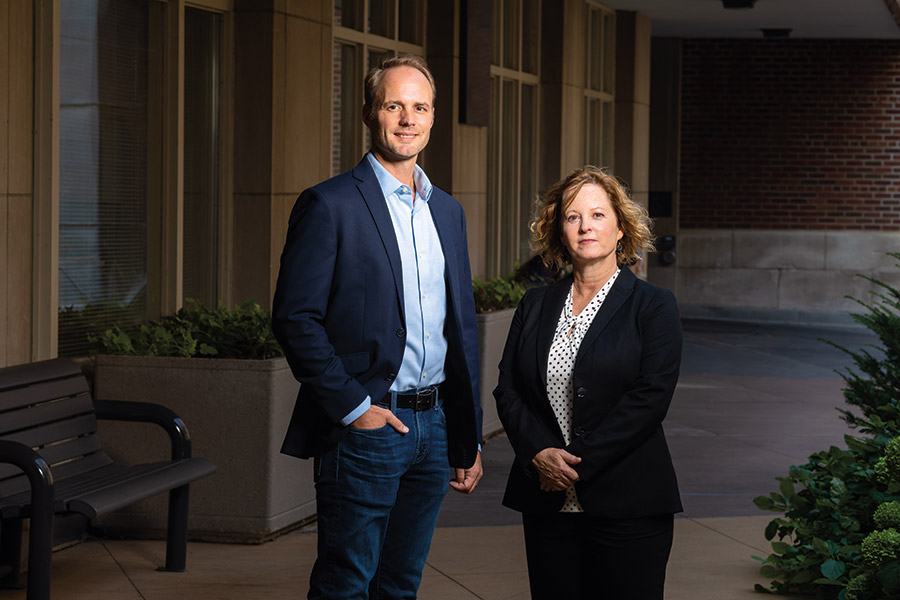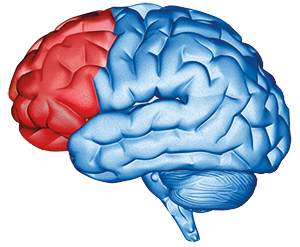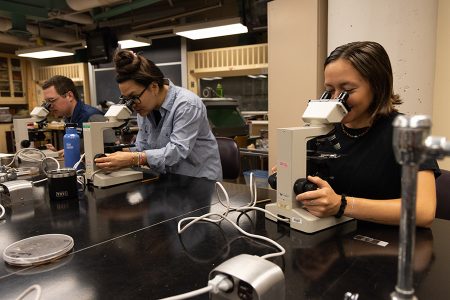Engaging too long and hard in any profession can lead to burnout, but those who spend day after day caring for people are particularly susceptible. Admitting to the damage stress has on your life was once taboo in the medical field, now the pandemic is allowing people to open up about what happens when our brains and bodies have a hard time coping.
There was immediate concern about those who were most at risk for COVID-19 when the SARS CoV-2 virus came to America in 2020: the elderly, the immunocompromised, and people with comorbidities like pulmonary disease, heart disease, diabetes, and obesity. There were worries, too, about those whose jobs don’t allow them to shelter in place — people such as agricultural workers, energy-industry workers, transit workers, and police.
And then there were the people of medicine, who not only had to gear up to battle the virus but who had to run the risk of exposure to it. As hospitals filled with suffering patients afflicted with a disease then poorly understood and regularly fatal, healthcare workers were exposed to another risk: long periods of stress that, if unmanaged, could turn toxic and lead to burnout, a state of psychic depletion extreme enough to leave practitioners hopeless about their work.
These soldiers on the front line of a pandemic fought hard; and they’re still fighting. Meanwhile a pair of University of Minnesota researchers are working to understand what these practitioners have been going through — the exposure, the stress, the frustration and sorrow, the threat and reality of burnout, and how all those factors interact.
SPH Associate Professor Ryan Demmer (PhD ’05, MPH ’01) and Professor Jayne Fulkerson, a psychologist in the School of Nursing and SPH affiliate faculty member, are past the midpoint of a project funded by a COVID-19 Rapid Response grant from the Office of the Vice-President for Research (OVPR). They’re studying the physical and psychological effect of the pandemic on a wide range of healthcare workers with the hope of finding the best ways to support them as they save others’ lives and protect their own.
The details of stress
Beginning in December of 2020, Demmer and Fulkerson have been regularly checking in with a cohort that includes some 400 employees of M Health Fairview, from physicians and nurses to social workers and other clinical support people, learning whether they have contracted COVID, how their daily mobility patterns correlate with their state of health, how stressed they are, and how they feel about their calling.
An interview and two follow-up surveys to assess stress are combined with biweekly health checks focusing on exposure to the virus. “We start with basic things like age, gender, race/ethnicity, and where you work — in the ICU, in an outpatient, ambulatory setting,” says Demmer. “Are you treating COVID patients frequently? Have you been exposed to a known positive patient? We’re trying to get a sense of how close to COVID they are in their healthcare setting. And then there are a lot of questions on stress.”

Respondents rate their stress levels and whether they are feeling anxious or depressed. There are questions about work overload and what could be done to make their work lives better, such as adjusting the flow of patients to more consistently separate those known to have COVID from possible-COVID and clearly non-COVID cases.
“And there are other issues we address, too, like whether they have consistency in teams from shift to shift, so they’re working with the same people,” Demmer says. “Do they have good amenities in their break rooms, like healthy food, and are there adequate breaks? Are they tested regularly for COVID? And we ask about the impact on their families, and whether or not the practitioners think they will continue to work in healthcare post-COVID.”
A third element in the study is mobility tracking. One hundred study participants have agreed to use the Daynamica time-use app, developed by SPH Associate Professor Julian Wolfson, to allow Demmer and Fulkerson to assess their movements.
“We want to find out things like, how frequently they are out of their home and how frequently at work, and do parameters of that nature actually predict the risk of infection.” Demmer says. “We can also cross-tabulate those findings with the health and well-being questions to see if people who were out and about more often are more or less stressed. Did that activity provide some buffer for them against the stress?” And, he adds, there’s a question that goes the other way: Does being out and about more put workers at greater risk of infection even though it might help them deal with stress?
“We hope the study will identify the burden of stress and reduced mental health among healthcare professionals during the pandemic,” says Demmer. “We also hope to learn who among the broad healthcare workforce is carrying the greatest burden, and what aspects of the pandemic are of greatest concern to them. We ultimately want to bring resources to healthcare professionals that help them reduce work-related stress and improve their mental health.”
Wellness plus well-being
Fulkerson and Demmers’s melding of the physical and the psychological — of body and mind, or wellness and well-being — is the result of a coincidence. The two researchers initially applied for separate OVPR grants; Demmer to look at the risks of COVID transmission in health-care settings, and Fulkerson to gauge the psychological health of COVID fighters and their burnout risk.
“We ultimately want to bring resources to healthcare professionals that help them reduce work-related stress and improve their mental health.”
Ryan Demmer
Demmer’s research had long focused on cardiometabolic disease, including heart attacks, strokes, diabetes, and heart failure. He has studied the relationship between infectious disease and these conditions, usually with an emphasis on bacteria rather than viruses.
“I’ve always been thinking about how microbes trigger the development of chronic disease pathways,” he says. “So when SARS-CoV-2 hit, I started wondering about what the long-term cardiometabolic impacts could be among people who get infected. We’ve already seen a lot of hints that people who are infected with SARS-CoV-2 are more likely to experience adverse events related to cardiovascular disease and diabetes.”
He also found himself more and more interested in risk factors for COVID infection in health-care settings and how asymptomatic people could transmit the virus.
Fulkerson is concerned about the psychological health of nurses, the frontline workers who spend the most time with patients. She saw the grant as an opportunity to work with one of her grad students, who was thinking of researching healthcare providers and stress.
“When the Vice President’s office got our two proposals, both surveying healthcare workers, they suggested we collaborate so that we wouldn’t overburden providers with two surveys,” she says. “We met and said, well, we have completely different aims, but it really is possible to combine our studies into one and go from there. It’s been an unexpected but great experience to work together.”
“When what they were going through hit them, I would find them unable to even move, and then I would send them home, and the worry would set in on me….It was a lot for me, and so I would say after about six months, I started to break. ”
Angela Whitley
Bryan Williams, a pulmonologist who, as Chief Well Being Officer at M Health Fairview, is responsible for supporting the mental and emotional health of the system’s staff. He was so convinced of the importance of Demmer and Fulkerson’s work that he collaborated with them. Another important collaborator was Mark Linzer of Hennepin Healthcare, who has long been studying burnout and developed the questionnaire about stress, called the Mini-Z, that Fulkerson adapted for the project.
The ever-present stress factor
The stresses of practicing medicine — of making decisions and taking actions that can make the difference between suffering and recovery, and sometimes life and death — have been recognized for a long time.
But recent developments in the world of healthcare have contributed new stressors. As private practices have dwindled, many physicians and advanced practitioners have become employees of large organizations, subject to productivity requirements, tight scheduling, and other corporate mandates. The increasing use of electronic medical records (EMRs) has brought time-consuming coding and data entry. Aging patients present complex conditions; medical insurers limit what procedures can be adopted…the list goes on, and stresses can mount. Unmanaged stress over time can lead to burnout.
In 1983, University of California social psychologist Christina Maslach offered a now-classic three-part definition of burnout: a psychological syndrome involving emotional exhaustion, depersonalization, and a diminished sense of personal accomplishment. Practitioners feel “tapped out” in terms of energy; they lose connection with patients and colleagues and become angry or cynical; they feel that their work is pointless and that their skills don’t matter. The results can be medical errors, problems with colleagues, depression, substance abuse, and even suicide.
“The way we think of burnout now is as a sense of disconnection from your job that makes you not want to do it anymore,” says Williams. “One of the other things that go into it is the notion of moral distress; when you’re being told you have to do something that doesn’t sit well with you, whether it’s taking care of patients who are at the end of their lives and being told you have to keep them going — performing CPR on somebody you know doesn’t have a chance — or not being able to order a test because an insurance company has denied you.”
With the pandemic, of course, the chronic stress of overwork was yoked with the moral costs of sometimes agonizing decision-making (which patients get ventilators?) and the toll taken on practitioners as so many patients died, usually without loved ones present.
“Those types of things start to stack up and create anguish that contributes to burnout,” Williams says.
On the frontlines
One provider who understands burnout first-hand is Angela Whitley, an RN who managed the intensive care units at Bethesda Hospital, the Twin Cities region’s first COVID-dedicated facility. She supervised some 300 nurses, many of whom were transferring in from other locations across the country, including New York, where the pandemic was at its worst.
“I had to figure out what these nurses’ skills were, what they could manage, what they couldn’t manage,” she says. “When what they were going through hit them, I would find them unable to even move, and then I would send them home, and the worry would set in on me. Are they safe? They came from all across the country, and they’re socially isolated. Everything is closed. They can’t go out. They’re struggling in their relationships. Some are becoming alcoholics. Some are suicidal. It was a lot for me, and so I would say after about six months, I started to break.”
Whitley saw a therapist and began to realize that she was, indeed, burning out.
“It was around October when I really felt myself slipping,” she says. “I wasn’t myself anymore. I was really angry, and I’m sure it was extremely hard to be around me. I wasn’t managing effectively anymore, and I knew it. I knew that emotionally and physically I couldn’t do it anymore. Once I finally admitted that, and I actually told my staff, it was a big relief.” She resigned and took contract work with the state Department of Health and FEMA, running vaccine clinics.
“A lot of the pain was about the deaths, but it was more than that,” says Whitley. “We’re medically trained, we can accept death when it’s inevitable. But it was the unfairness. You have a 32 year old with no comorbidities, two young children, and he dies, and you are left asking, what the hell? Or you’re in the room with the patient, trying to comfort his family over an iPad, and you’re the one that says, ‘he just took his last breath. I’m really sorry.’ That was hard.”
For Sakina Naqvi, a pulmonary critical-care specialist at M Health Fairview who also worked at Bethesda, the beginning of the pandemic was frightening. “We didn’t know how the disease was spreading; we were short of protective equipment; we didn’t know how seriously people would take the guidance that was being put out by the government,” she says. “There was a lot of fear on the part of anyone who was patient-facing.”
Changing the system to prevent Burnout
Burnout can, in many ways, be attributed to a system that has neglected to pay attention. To address this, the American Medical Association has offered its own five anti-burnout strategies, and they are institutional. The AMA says that practitioners need:
- More research on burnout and its causes.
- Redesign of work systems and workflows to reduce stress.
- Reduction of the administrative burden: less paperwork.
- Reduction of complex and time-consuming digital record-keeping.
- Elimination of the stigma that can keep medical people from seeking mental-health care.
The Physiology of Burnout
When stress leads to burnout, just what’s going on in our brain?

According to recent research, burnout is basically a malfunction of the brain’s prefrontal cortex (PFC). This region governs a number of cognitive operations that are important to front-line healthcare workers, including insight, abstract reasoning, higher-order decision making, and perseverance in the face of challenges.
Uncontrollable or uncontrolled stress can produce an excess of chemicals known as arousal modulators, including norepinephrine, dopamine, and acetylcholine. This chemical overdose can weaken connections between nerve cells in the PFC and result in cognitive impairment. And that, in turn, can affect working memory and attention regulation, and lead to poor decision making and other cognitive problems.
If cascades of arousal modulators are the result of stress and our inability to control it, research suggests that we need to help practitioners manage stress, both by helping them become more conscious of how they’re feeling and by giving them a stronger voice in improving stressful working conditions.
SOURCE: Amy F. T. Arnsten and Tait Shanafelt, MD, “Physician Distress and Burnout: The Neurobiological Perspective,” Mayo Clinic Proceedings March 1, 2021.



